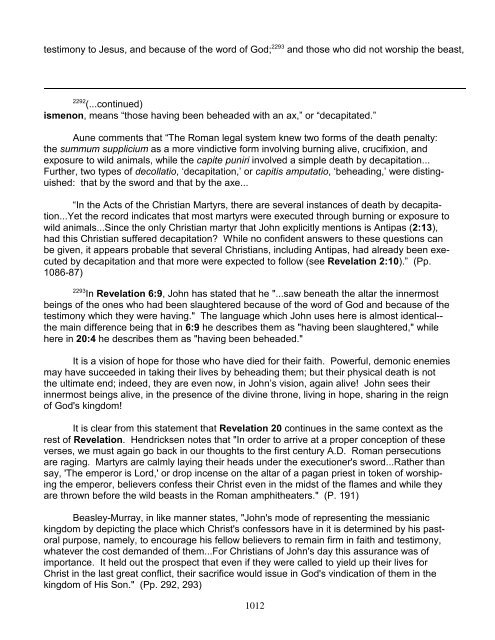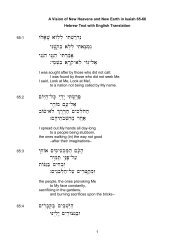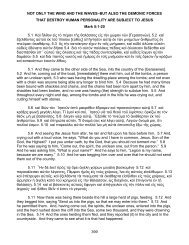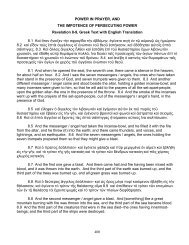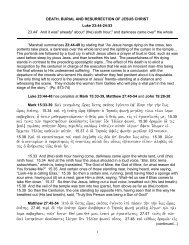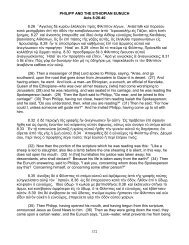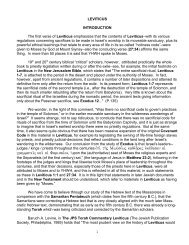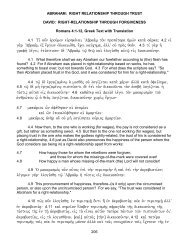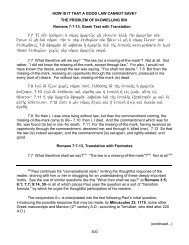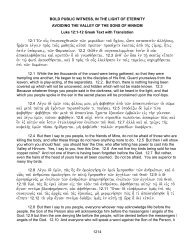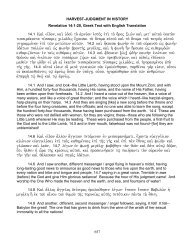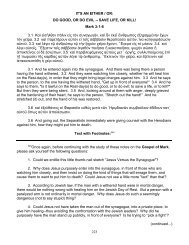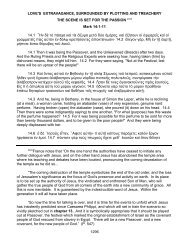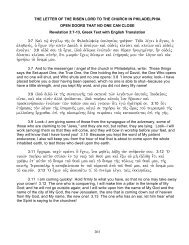Revelation 20 - In Depth Bible Commentaries
Revelation 20 - In Depth Bible Commentaries
Revelation 20 - In Depth Bible Commentaries
Create successful ePaper yourself
Turn your PDF publications into a flip-book with our unique Google optimized e-Paper software.
2293<br />
testimony to Jesus, and because of the word of God; and those who did not worship the beast,<br />
2292<br />
(...continued)<br />
ismenon, means “those having been beheaded with an ax,” or “decapitated.”<br />
Aune comments that “The Roman legal system knew two forms of the death penalty:<br />
the summum supplicium as a more vindictive form involving burning alive, crucifixion, and<br />
exposure to wild animals, while the capite puniri involved a simple death by decapitation...<br />
Further, two types of decollatio, ‘decapitation,’ or capitis amputatio, ‘beheading,’ were distinguished:<br />
that by the sword and that by the axe...<br />
“<strong>In</strong> the Acts of the Christian Martyrs, there are several instances of death by decapitation...Yet<br />
the record indicates that most martyrs were executed through burning or exposure to<br />
wild animals...Since the only Christian martyr that John explicitly mentions is Antipas (2:13),<br />
had this Christian suffered decapitation? While no confident answers to these questions can<br />
be given, it appears probable that several Christians, including Antipas, had already been executed<br />
by decapitation and that more were expected to follow (see <strong>Revelation</strong> 2:10).” (Pp.<br />
1086-87)<br />
2293<br />
<strong>In</strong> <strong>Revelation</strong> 6:9, John has stated that he "...saw beneath the altar the innermost<br />
beings of the ones who had been slaughtered because of the word of God and because of the<br />
testimony which they were having." The language which John uses here is almost identical--<br />
the main difference being that in 6:9 he describes them as "having been slaughtered," while<br />
here in <strong>20</strong>:4 he describes them as "having been beheaded."<br />
It is a vision of hope for those who have died for their faith. Powerful, demonic enemies<br />
may have succeeded in taking their lives by beheading them; but their physical death is not<br />
the ultimate end; indeed, they are even now, in John’s vision, again alive! John sees their<br />
innermost beings alive, in the presence of the divine throne, living in hope, sharing in the reign<br />
of God's kingdom!<br />
It is clear from this statement that <strong>Revelation</strong> <strong>20</strong> continues in the same context as the<br />
rest of <strong>Revelation</strong>. Hendricksen notes that "<strong>In</strong> order to arrive at a proper conception of these<br />
verses, we must again go back in our thoughts to the first century A.D. Roman persecutions<br />
are raging. Martyrs are calmly laying their heads under the executioner's sword...Rather than<br />
say, 'The emperor is Lord,' or drop incense on the altar of a pagan priest in token of worshiping<br />
the emperor, believers confess their Christ even in the midst of the flames and while they<br />
are thrown before the wild beasts in the Roman amphitheaters." (P. 191)<br />
Beasley-Murray, in like manner states, "John's mode of representing the messianic<br />
kingdom by depicting the place which Christ's confessors have in it is determined by his pastoral<br />
purpose, namely, to encourage his fellow believers to remain firm in faith and testimony,<br />
whatever the cost demanded of them...For Christians of John's day this assurance was of<br />
importance. It held out the prospect that even if they were called to yield up their lives for<br />
Christ in the last great conflict, their sacrifice would issue in God's vindication of them in the<br />
kingdom of His Son." (Pp. 292, 293)<br />
1012


